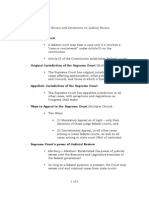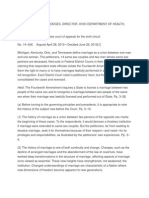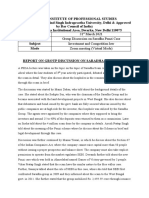0% found this document useful (0 votes)
981 views6 pagesClassifying Arguments Activity-Answer Key: Obergefell v. Hodges (And Consolidated Cases)
1. The Supreme Court consolidated four cases challenging state bans on same-sex marriage to decide whether the 14th Amendment requires states to license and recognize same-sex marriages.
2. The cases involved issues of federalism and equal protection under the 14th Amendment. Plaintiffs argued bans violated equal protection, while states argued they had the right to define marriage under principles of federalism.
3. The Court was tasked with determining the appropriate level of scrutiny (rational basis, intermediate, or strict) to apply to laws discriminating on the basis of sexual orientation, and whether the bans were constitutional under that level of scrutiny.
Uploaded by
zombielibraryCopyright
© © All Rights Reserved
We take content rights seriously. If you suspect this is your content, claim it here.
Available Formats
Download as PDF, TXT or read online on Scribd
0% found this document useful (0 votes)
981 views6 pagesClassifying Arguments Activity-Answer Key: Obergefell v. Hodges (And Consolidated Cases)
1. The Supreme Court consolidated four cases challenging state bans on same-sex marriage to decide whether the 14th Amendment requires states to license and recognize same-sex marriages.
2. The cases involved issues of federalism and equal protection under the 14th Amendment. Plaintiffs argued bans violated equal protection, while states argued they had the right to define marriage under principles of federalism.
3. The Court was tasked with determining the appropriate level of scrutiny (rational basis, intermediate, or strict) to apply to laws discriminating on the basis of sexual orientation, and whether the bans were constitutional under that level of scrutiny.
Uploaded by
zombielibraryCopyright
© © All Rights Reserved
We take content rights seriously. If you suspect this is your content, claim it here.
Available Formats
Download as PDF, TXT or read online on Scribd
/ 6


































































































